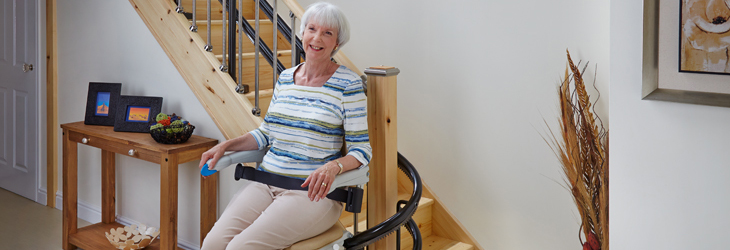Everything You Want to Know About Stair Lifts Is Right Here
Posted by Susan T. on Mar 22nd 2021
Many people with reduced mobility experience difficulty climbing up and down the stairs. Stair Lifts and Vertical Home Lifts help alleviate this issue by offering a simple, easy way to travel up and down their home in comfort.

How Does a Stair lift Work?
A Stair Lift is a mechanical device designed to lift people up and down the stairs. A motorized chair travels along a rail that is securely bolted to the steps. A person gets into the motorized chair and is lifted up or down the stairs. You can easily operate a stair lift with remote control.
Stair lifts are also known as chair lifts and stair gliders. They come in a variety of styles including curved rail, indoor, outdoor, and straight rail.
A stair lift utilizes two 12-volt batteries that are continuously charged by a wall outlet. Since they are powered by batteries, stair lifts can operate even during power outages.
Who Needs Stair lifts?
A stair lift is for anyone who has difficulty climbing stairs but can still stand. A stair lift can also benefit a person who uses a wheelchair and has adequate upper body strength to move from their wheelchair to their lift safely.
Safety Features
Stair lifts come loaded with safety features. They use sensors to detect potential obstructions. Safety belts on the seat prevent the user from falling off the stair lift. Swiveling footplates bridge the gap between the stair lift and the top of the stairs. Stair lifts have mechanical and electrical braking systems designed to stop them smoothly and safely.
Types of Stair lifts
Straight-Rail Stair lifts
As the name suggests, straight-rail stair lifts have a straight rail. They are usually used in homes with straight stairs. Straight-rail stair lifts are easy to install and can be installed within a reasonable period of time. The rail of a straight-rail stair lift is simply cut to length from a stock part. Straight-rail stair lifts are one of the least expensive stair lifts due to the relatively simple nature of their rail.
Outdoor Stair lifts
Outdoor Stair Lifts are installed on curved and straight staircases. You can fit an outdoor stair lift to a full flight of outdoor stairs or even a few steps leading to the garden. They are waterproof and designed to withstand the elements and rigors of outdoor use.
Wheelchair Vertical Home Lifts
Wheelchair Vertical Home Lifts are used for transporting wheelchairs or mobility scooters with people. They are usually used in public access buildings and homes.
A wheelchair vertical platform stair lift has a wide platform to accommodate a wheelchair or scooter and the user.
Some vertical platform lifts have folding edge flaps that drop down to act as ramps. They also prevent the wheelchair from going over the edge of the platform. They have heavy-duty rails designed to support the weight of mobility aids.
A vertical platform lift's drive system is usually accommodated within an aluminum extrusion or tubular section rail. Many models either have steel cables or chains inside the tube, while others use a rack and pinion system. Some vertical platform lifts can be moved and used as indoor wheelchairs.
Curved-rail Stair lifts
A Curved-Rail Stair Lifts is designed to mimic the shape of an individual staircase. If you have a staircase with intermediate flat landings, a curved-rail stair lift will eliminate the need for multiple straight stair lifts.
Curved-rail stair lifts are more expensive than stair lifts for straight stairs due to two reasons: the stairs are custom-made to mimic the shape of the staircase and the chair is more complex. It usually takes longer to install a curved-rail stair lift than a straight domestic stair lift due to their complexity.
Standing or Perching Stair lifts
They are usually used for narrow staircases that do not have enough room for a seated lift. When installing a standing stair lift, make sure it offers plenty of headroom. Some perching stair lifts have a small ledge to help the user keep their balance. Standing stair lifts are ideal for people who experience problems bending their knees.
However, standing lifts are not for everyone. If you are unable to stand for a few minutes or suffer from recurring dizzy spells, consider one of the previously mentioned styles of stair lifts instead of a standing lift.
Benefits of Stair lifts
Stair lifts offers the following benefits:
➢ Prevents Injuries: People with mobility impairments can miss a step while walking up or down a staircase and fall and hurt themselves. Stair lifts provide a safe and easy way to go up and down the stairs allowing them to go up or down stairs in confidence and comfort.
➢ Easy to use: Operating a stair lift is as easy as one-two-three. To use your stair lift, sit on the seat, fasten the seatbelt, and press & hold the rocker switch to go up or down. To stop the lift, release the switch.
➢ Restores independence: A stair lift will help you fully utilize previously inaccessible areas (such as your basement or upper level if your house has multiple stories). You will be able to get up and down the stairs without assistance.
Shop Stair Lift and other Home Access Equipment
Mobility Masters offers a range of mobility assistance devices like Bruno, Harmar, and Handicare. We are committed to making a positive difference in the lives of people with mobility impairments. Have questions about our products? Call us at (800) 936-7006.




